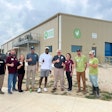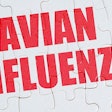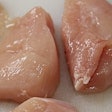These include pulsed electric fields, hydrostatic pressure, and manothermosonication treatments. Irradiation has also been investigated as a method for pasteurizing liquid as well as shell eggs. In a new research project, Alvarez et al., 2006 (Journal of Food Protection 69:2066-2074) investigated the effect of irradiation (ionizing radiation) followed by heat pasteurization on survival of Salmonella in liquid whole egg (LWE).
Eggs were sanitized with 70% ethanol and aseptically broken, transferred to a sterile stomacher bag and mixed. The liquid whole egg was inoculated with six serovars of Salmonella (S. anatum 9270, S. Dublin 15480, S. enteritidis 13076, S. Newport 6962, S. senftenberg 8400 and S. typhimurium 14028) at a final cell concentration of approximately 109 CFU/ml. for each Salmonella serovar. Inoculated LWE was irradiated at 0, 05. 1.0, 1.5, 2.0, 2.5 or 3.0 kGy followed by heat treatment at 55 , 57 or 60 C at various time intervals.
Heat, radiation resistance
S. senftenberg was found to be the most resistant to radiation and heat. Previous research has also shown that S. senftenberg is quite heat resistant. Results showed that irradiation followed by heat treatment at 55 to 57 C improved the effectiveness of the pasteurization process. These authors indicated that radiation doses as low as 0.1 kGy prior to thermal treatments synergistically decreased D55 and D57 of S. senftenberg 3.6-fold and 2.5-fold, respectively. S. typhimurium D55 and D57 were reduced 2- and 1.4-fold while D55 and D57 for S. enteritidis were reduced 2- and 1.6-fold, respectively, following radiation doses of 0.1 kGy. This synergistic effect was not observed at 60 C. They postulated that heating at 60 C following irraditation may have generated conditions for heat resistant S. enteritidis cells. More research was proposed on this aspect.
These authors concluded that irradiation prior to heat treatment would reduce heat treatment times by 86 and 30% at 55 and 57 C, respectively. They concluded that these treatments would inactivate 9 log units of Salmonella secrovars. These scientists felt that irradiation plus thermal treatment may have real promise as a pasteurization process to produce a Salmonella free LWE product.
There have been concerns in the past for utilization of irradiation pasteurization by the food industry. Attempts to implement irradiation processing in the United States have not been promising. Although past research has indicated that irradiation pasteurization is safe, the consumer has been reluctant to accept this process. There is also a need to determine the effect of this combined process on the functional and sensory properties of LWE. Since egg proteins are quite susceptible to heat pasteurization, there is continuing interest to investigate alternative methods for pasteurizing eggs.


















